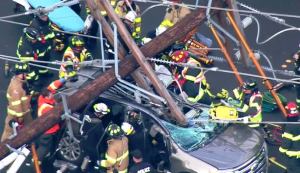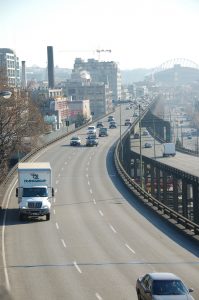 A construction crane collapsed from the roof of a building on Saturday afternoon tragically killing four people and injuring four others. Two of the people killed were ironworkers and two others were bystanders. The crane was positioned on the new Google Seattle campus and was in the process of being dismantled when it fell.
A construction crane collapsed from the roof of a building on Saturday afternoon tragically killing four people and injuring four others. Two of the people killed were ironworkers and two others were bystanders. The crane was positioned on the new Google Seattle campus and was in the process of being dismantled when it fell.
The Washington State Department of Labor and Industries is investigating five companies involved in the accident: Seaburg Construction Corp., GLY Construction, Northwest Tower Crane Service Inc., Omega Rigging and Machinery Moving Inc., and Morrow Equipment Co. LLC. The Department of Labor and Industries spokesman said that it is too early to speculate on the cause of the accident and the investigation could take up to six months and would including interviewing workers and accessing company records among other investigation.
According to an article by CNN, after a construction company is finished using a crane, disassembly can take between two and three days. The disassembly process requires taking the crane apart piece by piece. The article suggested that construction workers could have prematurely removed or loosened the pins connecting the crane all at once instead of in sections. Workers sometimes do this in order to save time during dismantling. But if pins are removed prematurely, portions of the crane become unsecure and unstable. At the time of the accident, relatively minor wind gusts between 18 and 23 mph were reported in the area and could have contributed to the collapse.
 Seattle Injury Lawyer Blog
Seattle Injury Lawyer Blog


 A fun day out on the water could turn into a fatal accident, if the mast of your sailboat comes into contact with a low electrical line. In order to keep the public safe, the National Electrical Safety Code (NESC) publishes clearance requirements for electrical lines that hang over bodies of water.
A fun day out on the water could turn into a fatal accident, if the mast of your sailboat comes into contact with a low electrical line. In order to keep the public safe, the National Electrical Safety Code (NESC) publishes clearance requirements for electrical lines that hang over bodies of water. On Friday April 5th, 26 utility poles fell on East Marginal Way in South Tukwila around 3:50pm. One Seattle couple is thankful to survive after one of the poles smashed through the windshield of their car trapping them inside. Luckily, the couple, Tom and Linda Cook, only suffered minor cuts and bruises.
On Friday April 5th, 26 utility poles fell on East Marginal Way in South Tukwila around 3:50pm. One Seattle couple is thankful to survive after one of the poles smashed through the windshield of their car trapping them inside. Luckily, the couple, Tom and Linda Cook, only suffered minor cuts and bruises. If an electrical system does not have a fault protection system and proper grounding in place, electrical faults pose a substantial risk of injury. An electrical fault occurs when there is an abnormal electrical current, such as an over current, under voltage, unbalance of the phases, reversed power, and high voltage surge. A fault can be very dangerous and destructive causing fire, explosion, or electrical shock to persons nearby. These dangers to people are in addition to the damage faults may cause to the electrical system itself.
If an electrical system does not have a fault protection system and proper grounding in place, electrical faults pose a substantial risk of injury. An electrical fault occurs when there is an abnormal electrical current, such as an over current, under voltage, unbalance of the phases, reversed power, and high voltage surge. A fault can be very dangerous and destructive causing fire, explosion, or electrical shock to persons nearby. These dangers to people are in addition to the damage faults may cause to the electrical system itself. Driving under the influence of marijuana is dangerous and potentially deadly. According to the 2018 Washington Traffic Safety Commission survey, “Marijuana Use, Alcohol Use, and Driving in Washington State,” driver impairment due to alcohol and/or drugs is the number one contributing factor in Washington State fatal crashes. Marijuana is second only behind alcohol to appear in drivers involved in accidents, and the number of drivers under the influence of marijuana is increasing each year. Many of these accidents occur on the busy Interstate 5, Interstate 90, and Interstate 405. According to the results of the Washington State Roadside Survey, nearly one in five daytime drivers may be under the influence of marijuana. This statistic is up from less than one in 10 drivers prior to the implementation of marijuana retail sales in Washington State in 2014.
Driving under the influence of marijuana is dangerous and potentially deadly. According to the 2018 Washington Traffic Safety Commission survey, “Marijuana Use, Alcohol Use, and Driving in Washington State,” driver impairment due to alcohol and/or drugs is the number one contributing factor in Washington State fatal crashes. Marijuana is second only behind alcohol to appear in drivers involved in accidents, and the number of drivers under the influence of marijuana is increasing each year. Many of these accidents occur on the busy Interstate 5, Interstate 90, and Interstate 405. According to the results of the Washington State Roadside Survey, nearly one in five daytime drivers may be under the influence of marijuana. This statistic is up from less than one in 10 drivers prior to the implementation of marijuana retail sales in Washington State in 2014.